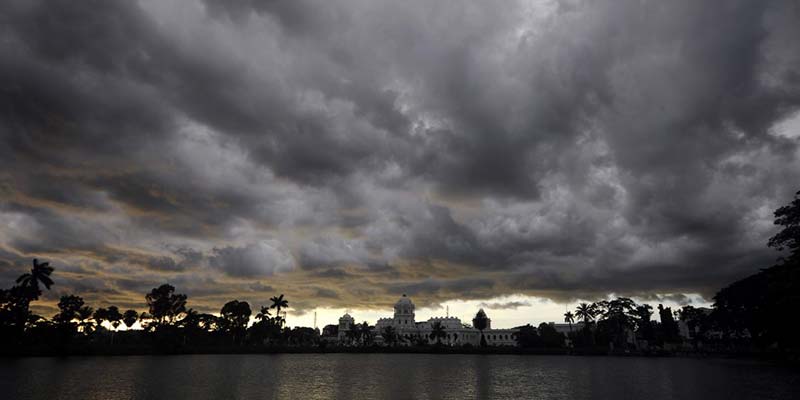- India
- Apr 12
IMD predicts normal monsoon for this year
• India is expected to get normal rainfall during the southwest monsoon season, the India Meteorological Department (IMD) said on April 11.
• India to see normal rainfall during the southwest monsoon season (from June to September). It is likely to be 96 per cent (with an error margin of 5 per cent) of the long period average (LPA) of roughly 87 cm, IMD said.
• Currently, La Nina conditions changed to neutral conditions over the equatorial Pacific region. The climate model forecast indicates that El Nino conditions are likely to develop during the monsoon season.
• Positive Indian Ocean Dipole (IOD) conditions are expected during the southwest monsoon season and the snow cover over the northern hemisphere and Eurasia was also below normal from December 2022 to March 2023.
• The Indian Ocean Dipole (IOD), also known as Indian Nino, is defined by the difference in sea surface temperature between two areas (or poles, hence a dipole) – a western pole in the Arabian Sea (western Indian Ocean) and an eastern pole in the eastern Indian Ocean south of Indonesia. A positive IOD is considered good for the Indian monsoon.
What is El Nino and La Nina?
• El Nino and La Nina events are a natural part of the global climate system. They occur when the Pacific Ocean and the atmosphere above it change from their neutral (‘normal’) state for several seasons.
• El Nino, which is the warming of the waters in the Pacific Ocean near South America, is generally associated with the weakening of monsoon winds and dry weather in India.
• The El Nino conditions this year follow three consecutive La Nina years. La Nina, which is the opposite of El Nino, typically brings good rainfall during the monsoon season.
• These changes in the Pacific Ocean and its overlying atmosphere occur in a cycle known as the El Nino–Southern Oscillation (ENSO).
• The term ‘El Nino’ translates from Spanish as ‘the boy-child’. Peruvian fishermen originally used the term to describe the appearance, around Christmas, of a warm ocean current off the South American coast. It is now the commonly accepted term to describe the warming of the central and eastern tropical Pacific Ocean. ‘La Nina’ translates as ‘girl-child’ and is the opposite ENSO phase to El Nino.
What is meant by long period average (LPA) of rainfall?
• LPA of rainfall is the rainfall recorded over a particular region for a given interval (like month or season) average over a long period like 30 years, 50 years, etc. It acts as a benchmark while forecasting the quantitative rainfall for that region for a specific month or season.
• The LPA of the seasonal rainfall over the country as a whole based on data of 1971-2020 is 87 cm.
How does the IMD forecast monsoon?
• The India Meteorological Department (IMD) issues operational forecast for the southwest monsoon season (June to September) rainfall for the country as a whole in two stages.
• The first stage forecast is issued in April and the second stage forecast is issued in May/June.
• Since 2021 IMD has implemented a new strategy for issuing monthly and seasonal operational forecasts for the southwest monsoon rainfall over the country by modifying the existing two stage forecasting strategy.
• The new strategy uses both dynamical and statistical forecasting system. Multi-Model Ensemble (MME) forecasting system based on coupled global climate models (CGCMs) from different global climate prediction centres, including IMD’s Monsoon Mission Climate Forecast System (MMCFS) is used in dynamical forecast system.
• April initial conditions have been used for generating the MME forecast for 2023 southwest monsoon season rainfall. Best climate models with the highest skill over the Indian monsoon region have been used to generate MME forecasts.
There are 5 categories of monsoon rainfall:
i) Deficient (less than 90% of LPA)
ii) Below normal (90 to 95% of LPA)
iii) Normal (96 to 104% of LPA)
iii) Above normal (105 to 110% of LPA)
iv) Excess (more than 110% of LPA).
Importance of normal monsoon in India
• Monsoon brings relief to dry and parched land in the form of rain, and affects Indian agriculture in a very substantial measure. The impact of monsoon on Indian economy is more pronounced.
• Normal rain is critical for India’s agricultural landscape, with 52 percent of the net cultivated area relying on it. It is also crucial for the replenishing of reservoirs critical for drinking water apart from power generation across the country.
• Rainfed agriculture accounts for about 40 percent of the country’s total food production, making it a crucial contributor to India’s food security and economic stability.
• Excessive rain leads to floods in certain areas, while little or no rain in other parts bringing drought and famine resulting in acute distress to millions.
Manorama Yearbook app is now available on Google Play Store and iOS App Store


